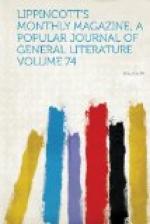The special charm of this book lies in the fact that it is not a book—that there was no thought in the writer’s mind of printer’s ink, no vision of publicity or fame, no solicitude to propitiate critics or win the sympathy of the “gentle reader.” Or one might say it was a book of the primitive kind, written on the bark of trees by some shy dryad, unconcious translator into speech of the rustlings and whisperings of the woodland. It is, as the editor observes, an “effortless narrative,” with “no attempt at fine or sensational writing, ... at that modern artifice which they call word-painting,” but recording with “vivid exactness” what was seen and felt by the writer and her companions on a journey through regions then little frequented by tourists and unsmirched by the eloquence of guide-books. That the travelers were William and Dorothy Wordsworth and (for a part of the way) S.T. Coleridge, that scenes and incidents here first sketched in the sister’s sober prose were afterward memorialized and moralized in the brother’s verse, and that many of the spots described were about to become famous with and through Scott—a meeting with whom formed the fitting close to the tour,—these are circumstances that of course invest the journal with a deeper interest and have called wider attention to its unobtrusive beauty. But its chief attractiveness lies in the Doric simplicity not only of the style but of the matter. An outlandish Irish car was the conveyance; the appearance of the party was not such as to attract notice unless by the quaintness of their garb or their awkward management of the horse, “now gibbing and backing over a bank, now reduced to a walk, with one of the poets leading him by the head;” and they themselves were in search of nothing more notable than such wayside objects as might serve to feed contemplation. On one occasion, having turned aside to visit the duke of Hamilton’s picture-gallery, they were told by the porter, after he had scanned them over, that they ought not to have come to the front door, and were directed to an obscure entrance at the corner of the house, where they seated themselves humbly on a bench while waiting for admittance, which was finally refused. They were mortified, but had a deeper pang in the grounds around Bothwell Castle, for here they were “hurt to see that flower-borders had taken place of the natural overgrowings of the ruins, the scattered stones and wild plants.” Sometimes at an inn they were made to perceive how little consideration they were entitled to by being lodged in inferior rooms while better ones were vacant; but to compensate for this, in the wilder parts of the country they were greeted with the hospitality which their mere condition as strangers was still sufficient to call forth. The descriptions given of the people have at least an equal interest with those of the scenery. We have a succession of pictures in which, as Principal Shairp remarks, “man is seen against a great background of Nature and solitude.” The book is one not to be read and laid away, but to be kept near at hand, and made a frequent companion and familiar friend.




